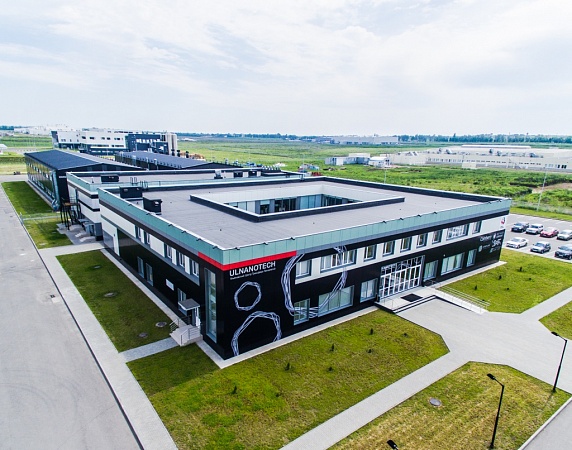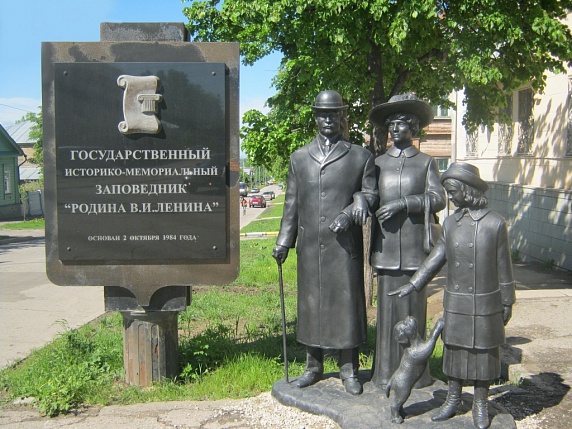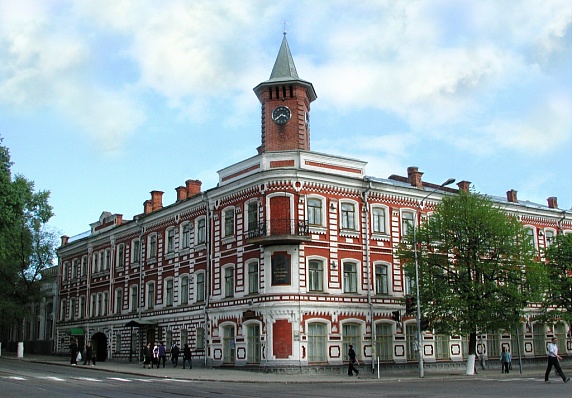 Ульяновская область
Ульяновская область
Ulyanovsk Region (passport)
Geographical position. The Ulyanovsk region is located in the central part of European Russia, in the very centre of the Middle Volga region, on both banks of the Volga river. The geographical middle of the Volga River is situated in Staromainskiy district of the Region. The Ulyanovsk region borders with the Penza region and the Republic of Mordovia in the west, Chuvash and Tatarstan Republics in the north, the Samara region in the east, the Saratov region in the south. The area size is 37,2 thousand sq.km (0,21% of the Russian Federation area) which is tantamount to the territories of such countries as the Kingdom of Belgium, the Netherlands or the Republic of Albania.
The climate is moderately continental. The average temperature is about 13 degrees centigrade below zero in January and 19 degrees centigrade above zero in July, with the average annual precipitation at 350-450 mm (16 inches).
Population. As of January 1, 2021, the population of the Ulyanovsk region made up 1 218 319 people. 76,1% of the total population of the region are city dwellers. The Ulyanovsk region is a densely populated area, the population density is 32,75 people per 1 sq.km of the territory. The ethnic structure of the Ulyanovsk region includes the following nationalities: Russians – 73,58%, Tatars – 12,24%, Chuvashs – 7,75%, Mordva – 3,18%, Ukrainians – 0,86%, Azerbaijanians – 0,38%, Armenians – 0,37%, Gipsies – 0.27%, Belarusians – 0.22%, Germans – 0.15%, Uzbeks – 0.12%, Tajiks – 0.1%, Bashkirs – 0.07%, Moldovans– 0.07%, Mari people – 0.05%, Jews – 0.04%, other nationalities – 0.54%. The overall ethnic structure of Ulyanovsk region includes over 120 ethnic groups.
The city of Ulyanovsk (625,5 thousand people) is the administrative centre of the region. Other large cities of the region are Dimitrovgrad – (112,4 thousand people), Inza – (17,0 thousand people), Barysh (15,4 thousand people) and Novoulyanovsk – (13,6 thousand people).
Administrative-territorial system. The Ulyanovsk region is comprised of 167 municipalities, which include 3 city districts (Ulyanovsk, Novoulyanovsk and Dimitrovgrad), 21 municipal areas, 31 city settlements and 112 rural settlements. The highest official of the Ulyanovsk region is the Governor of the Ulyanovsk region Alexey Yurievich Russkikh (from 4 October 2021). The supreme body of the executive power is the Government of the Ulyanovsk region. The supreme legislative body is the Legislative Assembly of the Ulyanovsk region elected for 5 years and consisting of 36 deputies. The chairman of the Legislative Assembly of the Ulyanovsk Region is Valeriy Vasilievich Malyshev who started his duty on 9 September 2018.
Heraldic attributes. The Ulyanovsk Region has official symbols – the coat of arms of the Ulyanovsk region, the flag of the Ulyanovsk region and the anthem of the Ulyanovsk region. The following heraldic description of the full coat of arms of the Ulyanovsk region has been established:
The coat of arms of the Ulyanovsk region is represented by a silver column with a figured capital and a base on the pedestal, crowned with the Imperial crown with flying azure ribbons, on the azure background. The shield is topped with a traditional demesne Crown (with gems on the hoop and three visible prongs in the form of acanthus leaves, interspersed with two visible smaller prongs with pearls). The Chargers are two gold lions, of which the right one holds three gold ears of wheat in the left forepaw and the left one - a gold sword in the right forepaw. Below the shield is a silver seagull flying to the right and touching the shield with its extended wings. The pedestal below the lions is decorated with gold oak branches. The motto “The pillar of Soul and State” is inscribed in azure letters on the gold ribbon.
The flag of the Ulyanovsk region represents an azure-coloured rectangular cloth where the height of the flag is 2/3rds of its width, with a white column and a figured capital and a base on the pedestal, with the Imperial crown on top, made in yellow, white and magenta colours with blue flying ribbons. The total height of the composition of the flag of the Ulyanovsk region is 9/10 of the width of the cloth.
The flag of the Ulyanovsk region is based on the image of the coat of arms of the Ulyanovsk region and corresponds to its heraldic description.
Historical information. The city was founded in 1648 as a fortress on the right bank of the Volga river called Venets (the height is more than 120 m) by the voivode and okolnichy Bogdan Matveevich Hitrovo and the dyak Grigory Kunakov with a view to strengthen the «Sinbirsk line». Until the end of the XVIII century the city of Sinbirsk preserved its name, which originated, according to one of the versions, from the duke of the Volgian Bulgaria named Sinbir, who established a small town Sinbirsk on the Volga, lower than the present Ulyanovsk is situated. On January 7, 1781 by order of Catherine II Simbirsk region ruled by the governor-general with an administrative centre in the city of Simbirsk was formed. In 1796 after the Simbirsk region ruled by the governor-general had been transformed into a province, Simbirsk became the principal city of the province. In 1924 the city was renamed into Ulyanovsk. Since 1928 Ulyanovsk was part of the Middle Volga region, since 1936 - of the Kuibyshev region. In 1943 the city became the centre of the newly formed Ulyanovsk region.
By the order of the Presidium of the Supreme Soviet of the USSR on April 20, 1966 No. 4724-VI "On awarding the Ulyanovsk region with the Order of Lenin", the Ulyanovsk region was awarded the Order of Lenin for the successes achieved in the development of the national economy.
By the order of the Presidium of the Supreme Soviet of the USSR No. 596-VIII on December 11, 1970 "On awarding the city of Ulyanovsk with the Order of Lenin", the city of Ulyanovsk was awarded the Order of Lenin for the great successes achieved by the city's workers in economic and cultural construction, in fulfilling the tasks of the five-year plan for the development of industrial production.
By the order of the Presidium of the Supreme Soviet of the USSR of June 11, 1982 "On awarding the city of Dimitrovgrad of the Ulyanovsk region with the Order of Peoples' Friendship", the city of Dimitrovgrad was awarded the Order of Peoples' Friendship for the successes achieved by the city's workers in economic and cultural construction, and their contribution to strengthening international ties.
By the order of the President of the Russian Federation on July 2, 2020 No. 444 "On conferring the honorary title of the Russian Federation" City of Labor Valor", the city of Ulyanovsk was awarded the honorary title "City of Labor Valor" for the significant contribution of residents to the achievement of Victory in the Great Patriotic War of 1941-1945, ensuring uninterrupted production of military and civilian products at the city's enterprises, showing massive labor heroism and dedication.
In the 1950s and 60s, the Ulyanovsk region turned into an industrial-agar region, and the city of Ulyanovsk became a major industrial center. As of January 1, 1966, there were 292 industrial enterprises in the region, including: the Dimitrovgrad Research Institute of Nuclear Reactors, the Ulyanovsk Instrument Design Bureau, the Ulyanovsk Plant of Heavy and Unique Machine Tools, the Ulyanovsk Mechanical Plant, the Ulyanovsk Radio Tube Plant, the Research and Production Association "Mars", the plants "Contactor" and "Kometa". The tannery, refrigeration plant, the confectionery factory "Volzhanka" and the factory "Rus" produced high-quality products. Also, the Melekesky (since 1972 Dimitrovgrad) industrial cloth Factory, the Novoulianovsky Cement Plant, the Novomainsky Carpet Factory, the Dimitrovgrad Carpet and cloth Factory, the Tsilninsky sugar factory, the Undorovsky plant "Volzhanka" and others produced their products. The automobile bridge (as the automobile turn of the existing railway bridge) was opened.
In the late 1960s, in connection with the preparation for the celebration of the 100th anniversary of Lenin's birth, architectural structures were built that still determine the appearance of Ulyanovsk: Lenin Memorial, new buildings of the Pedagogical Institute( University), the Palace of Pioneers, the Regional Children's Library, the new academic building of gymnasium No. 1, the high-rise hotel "Venets", the hotel "Sovetskaya", new buildings of the railway station and river port, a modern airport, the Palace of Culture of Trade Unions (now "Gubernatorial"), new residential neighborhoods.
In the 1970s and 80s. the plant "Gidroapparat" and the Dimitrovgrad Automobile Assembly plant began to turn out products. The plant "Iskra" quickly takes the place of one of the largest manufacturers of domestic small electronics. Since 1972, the serial production of the UAZ-469 car began, which became the main commander's car in the Soviet army and in the Warsaw Pact countries. In 1976 - 1985, the first stage of the Ulyanovsk Aviation Industrial Complex (UAIC) was built and put into operation, which still remains the largest aviation enterprise in Europe and Russia (now Aviastar-SP JSC). An-124 Ruslan became the pride of the Ulyanovsk aircraft industry. The Vostochny airport with a unique runway was built for its testing.
The fate of many outstanding people is connected with Simbirsk-Ulyanovsk: the historiographer N.Karamzin, the writers I.Goncharov, D.Grigorovich, the Wanderer (P.S Petrov), A.Korinfsky, the poets N.Yazykov, D.Minaev, N.Sadovnikov, D.Oznobishin, D.Davydov, the artists A.Plastov, D.Arkhangelsky, the composers A.Varlamov, O.Stankevich, the enlighteners I.Ulyanov and I.Yakovlev, decembrists I.Turgenev, V.Ivashev, architects F.Livchak, A.Shode, F.Volsov, biologist A.Lyubishchev, botanist V.Blagoveshchensky, zoologist S.Buturlin, conductor E.Serov, etc. V.Ulyanov (Lenin) was born here and spent the first 17 years of his life.
By the order of the President of the Russian Federation No. 277 on May 17, 2021, the Ulyanovsk (Baratayevka) international airport was named after N.Karamzin.
The socio-economic situation, the nature and potential of the economy, the place of the region in the economic life of Russia.
Almost a third of the gross regional product of the Ulyanovsk region is formed by the branches of the manufacturing sector of the economy. The construction of a diversified regional economy can be considered as one of the main drivers of growth. According to experts it has a European structure and it is characterized by a focus on the production of the final product. The high share of manufacturing industries in industrial production indicates that the region's labor resources are more highly qualified, and it indicates the region's potential in implementing complex technological and knowledge-intensive projects.
The stable entry of the region into the twenty most investment-attractive subjects of the Russian Federation is the result of the increase in the investment component in the economy of the region and the region's transformation into oneof the most investment-attractive in the country. According to the results of the first9 months of 2021, 51.1 billion rubles were invested in the economy of the Ulyanovsk region.
The Ulyanovsk Region is one of the few subjects of the Russian Federation in which, not only over the past 5 years, but also more, the industrial production index has not fallen below 100%, with the exception of 2020 (96.9%). In the first11 months of 2021 the industrial production index in the region reached a valueof 117%.
Having no significant areas and a" favorable " climate for crop production,the Ulyanovsk region is consistently one of the 20 leading regions in grain production. By the end of 2021, the gross value of agricultural production is expected to reach of 43.3 billion roubles.
The need of the population of the region for housing is fully satisfied. According to the results of 11 months of 2021, 768.8 thousand square meters were introduced in the region, the policy plan established for 2021 was completed by 94%.
The average salary according to the results of 10 months of 2021was 35.1 thousand rubbles, the growth rate was 110.3%. The registered unemployment rate as of December 01, 2021 was 4% of the economically active population.
International relations, the existence of agreements with foreign partners.
Nowadays the Ulyanovsk region is actively developing cooperation with such countries as Austria, Belarus, Vietnam, Germany, Denmark, Iran, Kazakhstan, China, Cuba, Turkey, France, Czech Republic, South Korea and Japan. Active cooperation is established with international organizations, including UNESCO, UNIDO, the World Bank, International Labour Organization, Council of Europe, CIS Executive Committee, Eurasian Economic Commission, European bank for Reconstruction and Development (EBRD), Association of European Businesses.
The Government of the Ulyanovsk region has concluded 8 agreements on cooperation with partners in foreign countries.
According to 11 months of 2021, the foreign trade turnover of the Ulyanovsk region amounted to 1215.6 million US dollars (increase by 26% compared to the same period in 2020). At the same time, imports of the region increased by 34% and amounted to 672 million US dollars, exports of the region increased by 17% and was equal to 544 million US dollars.
The share of the foreign trade turnover of the Ulyanovsk region in the foreign trade of the Volga Federal District amounted to 2.22%.
The trading partners of the Ulyanovsk region for 11 months of 2021 were 109 countries. The main trading partners were far-abroad countries. Their share in the turnover amounted to 85.09%, including 74.5% in exports and 93.7% in imports.
The largest trade partners in exports (93 countries in total): Algeria (35.8%), Kazakhstan (10.3%), USA (10.3%), Belarus (5.3%), Germany (5%), Cambodia (4.8%), Azerbaijan (4%), Ukraine (2.5%), Hungary (2.4%), China (2.1%).
in imports (74 countries): Japan (30%), China (18.9%), Germany (10.3%), Poland (6%), Spain (4.1%), Belarus (3.5%), Thailand (2.8%), Italy (2.8%), France (2.4%), Hungary (2.3%).
Science and education. Ulyanovsk Region is a region with a dynamic education system. In the region there are 473 educational organizations implementing the pre-school education program, 412 general education organizations (including 18 regional state institutions, 2 private institutions, 5 evening schools, 387 daytime municipal schools), 110 organizations of additional education and 516 educational organizations that implement additional education and sports training.
Currently, 51 organizations of secondary vocational education work on the territory of the Ulyanovsk region 45 of them are regional (31 are under the jurisdiction of the Ministry of Education and Upbringing of the Ulyanovsk Region, 2 - under the jurisdiction of the Ministry of Art and Cultural Policy of the Ulyanovsk Region, 1 - under the jurisdiction of the Ministry of Sports and Physical Culture of the Ulyanovsk Region). 8 organizations are federal, of which 7 are structural divisions and branches of educational organizations of higher education, and 3 are private educational organizations.
The system of higher education in the Ulyanovsk region is represented by 5 federal universities and 6 branches of universities, 4 of which are branches of nonresident universities, including 1 branch of a non-state university. Universities carry out educational activities in the following branches of science: mathematical and natural sciences; engineering, technology and technical sciences; health and medical sciences; agriculture and agricultural sciences, social sciences; education and pedagogical sciences; humanities; art and culture.
Culture, local traditions. The Ulyanovsk Region has been pursuing an active cultural policy active to increase the creative potential of the residents of the region, preserving the classical achievements of many cultural figures who were born and worked in Ulyanovsk, and also contributes to the development of modern trends in many areas of culture and art.
The cultural infrastructure of the Ulyanovsk region has a high functional diversity, meets many criteria for the availability of services of cultural organizations for the population, and takes into account the cultural and historical characteristics of the territories. On the territory of the Ulyanovsk region there are 1427 objects of cultural heritage (monuments of history and culture), 43 museums (including 1 federally-funded Motherland of Lenin Reserve Museum Preserve which incorporates 17 museums and 2 exhibition halls, 4 regional state museums: Lenin Memorial, uniting 4 museums, Ulyanovsk Regional Museum of Local Lore n.a. I.A.Goncharov with 3 branches and 1 external department, Ulyanovsk Regional Art Museum with 3 branches, Undorovsky Paleontological Museum, 10 municipal museums), 514 libraries, which incorporates 3 regional state libraries, 8 professional theaters (which incorporates 3 regional state theaters: Ulyanovsk Regional Drama Theater n.a. I.A. Goncharov, Theater of the Young Spectator, Ulyanovsk Regional Puppet Theater n.a. Valentina Leontieva with a branch in Dimitrovgrad, 1 Youth Theater, Dimitrovgrad Drama Theatre n.a. A.N. Ostrovsky and 2 non-state theaters).
Three major state orchestras glorify the Ulyanovsk region at various international and Russian venues: the State Academic symphony Orchestra "Gubernatorial", the State Orchestra of Russian Folk Instruments, the State Brass Band "Derzhava", as well as the State Song and Dance Ensemble" Volga "and the Pop Ballet "Exciton".
In the region there are 493 cultural and leisure institutions, 44 cinema halls, 3 professional educational organizations in the field of culture and art, 51 children's art schools. The work of the archive service is provided by 2 regional state archival institutions and 24 municipal archives.
Various festivals are held annually in the Ulyanovsk region: the International Music Festival "World, epoch, names…", the International Theater Festival "History of the Russian State", the International Festival of film and television programs for family viewing n.a. Valentina Leontieva "From the bottom of my heart", the International Assembly of Artists "Plastovskaya Autumn", etc.
Since 2011, the region has regularly hosted the International Cultural Forum, which has been held since 2013 under the auspices of the United Nations Educational, Scientific and Cultural Organization (UNESCO).
December 11, 2015, the city of Ulyanovsk joined the UNESCO Creative Cities Network in the field of "Literature". Today it is the only UNESCO city to represent Russia in the Network and cooperates with like-minded people from 39 cities around the world, recognising literature and creativity as essential elements of urban development. The programme "Ulyanovsk - a UNESCO Literary City" has become a platform for integration processes, uniting city and regional cultural organisations, libraries, public organisations, businesses, and literary figures. Ulyanovsk authors have got an opportunity to participate in numerous literary projects of creative cities of UNESCO.
The programme "Ulyanovsk - literary city of UNESCO" has been operating in Russia for six years. In 2019, the UNESCO General Office gave a positive assessment of the Ulyanovsk project team's activities and overall participation of the municipality in achieving the goals of the international project.
The Ulyanovsk region was the first among the regions of the Russian Federation to receive the title "Literary Flagship of Russia-2016", in 2019-2020-the honorary status "Territory of books and reading".
Non-governmental organizations. According to the Ministry of Justice of the Russian Federation there are 1982 non-commercial organizations registered in the Ulyanovsk region.
Mass media. At present there are 105 mass media of different types functioning in the Ulyanovsk region, including 67 periodicals. The top circulation of regional socio-political publications is held by “Molodyozhnaya gazeta” (over 9.500 copies). Most popular newspapers are “Narodnaya gazeta” and “Simbirsk Courier”.
The largest combined circulations of advertising and informational printed publications are held by “Mosaica” and "City Simbirsk" (over 200.000 copies). The total circulation of district newspapers in Ulyanovsk region is more than 53 thousand copies.
Television programs are produced by 10 registered TV Channels, the most popular are the branch of the Federal state unitary enterprise “All-Russian television and radio broadcasting company” “State Television and radio broadcasting company “Volga”, LLC "Reporter 73", "UlpravdaTV".
There are 26 radio channels and 2 radio programme registered in the region. The radio channel "2X2" broadcasts over 15 thousand news per year (with potential audience of over 900 thousand people). The radio channel "Militseyskaya Volna" broadcasts around 8 thousand news per year. Around 200 thousand people over 12 years old listen to Dorozhnoye Radio Ulyanovsk Channel.
Transport infrastructure, tourism and recreation possibilities.
Two international airports are located in Ulyanovsk: airport “Ulyanovsk - Vostochny” of class "A", which has ability to accept all types of aircraft without restrictions of their take-off weight, including aircraft AN-124 “Ruslan” and “Boeing-747”; and “Ulyanovsk airport (Baratayevka) n.a. N.M.Karamzin” of class "B", receiving flights from 6 airports of the Russian Federation. Gas filling infrastructure is being developed.
The administrative centre of the Ulyanovsk region - the city of Ulyanovsk is a large river port capable of receiving vessels of the "river - sea" type.
The organization of railway transportation is carried out by the Kuibyshev Railway, which is a branch of JSC "Russian Railways". In 2017, the building of the Ulyanovsk-Central Railway Station was overhauled and the adjacent territory was reconstructed. On average, 1,500 passengers leave the station per day.
The total length of the road network is 13.1 thousand km. Highways of the federal significance pass through the territory of the region, connecting the Ulyanovsk region with neighbouring regions: the republics of Tatarstan, Mordovia, Chuvashia, the regions of Samara, Saratov, Penza. The region contains the section of the international transport route "Europe - Western China" passing along the existing federal highways "Tsivilsk - Ulyanovsk" and "Access to Ulyanovsk from the M-5 highway Ural".
The Ulyanovsk region has a rich tourist potential capable of attracting guests, both from other subjects of the Russian Federation and from abroad.
The Volga River is one of the important factors attracting guests to the region. The presence of wide bays contributes to the development of recreational tourism in the region, making the coast convenient for hosting numerous recreation centers and parking places for yachts and other vessels. The width of the bay between the settlements of Undory and Staraya Maina is almost 40 km, which makes this part of the Volga the widest after the bay near the village of Kamskoye Ustye (Republic of Tatarstan).
Another feature of the Ulyanovsk region, due to its location on the banks of the Volga River, is the presence of two bridges in the regional centre - the 'Imperial', one of the oldest railway bridges in Russia, and the 'Presidential' bridge, which is 13 km long and was the longest bridge in Russia and one of the longest in Europe when it was opened in 2009.
There are currently 142 regional nature reserves including 125 natural landmarks, 17 state nature reserves, and 1 federal national park. In 2018, the "Undoria Geopark "was founded on the territory of the Ulyanovsk Region, which is the territory that claims to join the UNESCO network of global geoparks.
In 2020 in Ulyanovsk region another museum was opened at production: Balalaika Museum of the Balalaiker manufactory, a new ecological trail was developed in the Sengileevskie Gory National Park « In the footsteps of the groundhog». More than 30 new ecological, agrotourism routes and industrial excursions have been opened.
The country's largest "Head Branch Museum of the History of Civil Aviation" with a unique collection (50 units) of aircraft equipment is located in the Ulyanovsk region.
More than 40 various events are held annually in the region, including conferences and forums: "The Volga Way", "From the bottom of my heart", "World, epoch, names", "Japanese Spring on the Volga" and so on.
The Ulyanovsk region has a unique tourist potential. Ulyanovsk is the birthplace of V. I. Lenin, the city has many museums related to his life. Since 2013, the Ulyanovsk region has also been implementing an international tourist project "Red Route", which is one of the most promising projects in the field of tourism cooperation between Russia and China. There are more than 200 different thematic routes in the region.








